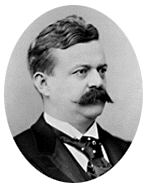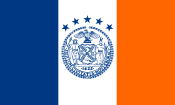Robert Anderson Van Wyck
| Robert Anderson Van Wyck | |
|---|---|
 Robert Anderson Van Wyck | |
| 91st Mayor of New York City | |
|
In office January 1, 1898 – December 31, 1901 | |
| Preceded by | William L. Strong |
| Succeeded by | Seth Low |
| Personal details | |
| Born |
July 20, 1849 New York, New York |
| Died |
November 14, 1918 (aged 69) Paris, France |
Robert Anderson Van Wyck (/vænˈwaɪk/;[1][2] July 20, 1849 – November 14, 1918) was the first mayor of New York City after the consolidation of the five boroughs into the City of Greater New York in 1898.[1][2]
Early life and education
Robert Anderson Van Wyck was the son of William Van Wyck and Lydia Ann Maverick. He was one of seven children, including a brother Augustus and a sister Lydia Maverick Van Wyck. He studied at the Wilson Academy in North Carolina, and later graduated from Columbia University, where he was valedictorian of his class. His sister Lydia married Robert Hoke of North Carolina, a Confederate general during the American Civil War and businessman.
Career
Van Wyck began working in business, then studied law and became an attorney. He enjoyed a large practice for many years before entering politics.
His business life depended on his social connections as well. Van Wyck was a member of the Holland Society, of which he became President. He belonged to many of the social clubs of the city, and was prominent in Masonic circles, being a member of The Ancient Lodge, New York City.
Political career
For many years Van Wyck took an active interest in Democratic Party matters, attending many conventions, state and national. Later, Van Wyck was elected Judge of the City Court of New York. He advanced to Chief Justice.
Van Wyck resigned as justice to accept the Democratic Party nomination for Mayor of New York City. He was elected in 1897 by a very large majority. He served as mayor of New York City between 1898 and 1901, as the first mayor to govern New York City after its five boroughs had been consolidated into a single city.
As Mayor, he brought together the innumerable municipal corporations comprising the greater city, adjusting their finances and bringing order out of almost total chaos. He directed construction of the Interborough Rapid Transit, the first subway in Manhattan, and provided for the construction of the proposed Brooklyn Tunnel.
Van Wyck is generally regarded as a colorless mayor, selected by the leaders of Tammany Hall as a man who would do little to interfere with their running of the city. Initially highly popular as a result of his reversal of the various reforms introduced by the preceding Fusion administration, Van Wyck's administration foundered on the so-called 'Ice Trust' scandal of 1900. The New York World reported that the American Ice Company of Charles W. Morse planned to double the price of ice, from 30 to 60 cents per hundred pounds (from 66 cents to 1.32 dollars per 100 kilograms). In the era before refrigeration, this had potentially fatal effects, as ice was the only preservative available to keep food, milk, and medicines fresh. The high price would have put ice beyond reach of many of the city's poor – Tammany's main power base in the years of waves of immigration.
American Ice was forced to reverse its decision due to the public outcry. Van Wyck's political rivals forced an investigation into the issue. It revealed that American Ice had secured an effective monopoly over the supply of its product to the city – it was the only company with rights to land ice at New York piers – and would have dramatically increased its profits at the new price. In addition, Van Wyck, whose salary as mayor was only $15,000, owned, and had apparently not paid for, $680,000 worth of American Ice stock.
The Ice Trust Scandal destroyed Van Wyck's political career and was generally reckoned to have cost Tammany the elections of 1901, which was won by the Fusion reformist slate led by Seth Low. Two years later, the New York Times characterized the Van Wyck administration as one mired in "black ooze and slime". Governor Theodore Roosevelt initiated an investigation, which determined that Van Wyck had not been personally implicated in the Ice Trust Scandal.[3]
Later years
Van Wyck and his wife enjoyed traveling. In 1906, they moved to Paris, France. He died there at the age of 69 on November 14, 1918. The funeral was held at American Holy Trinity Church. His body was returned to New York and he was buried at Woodlawn Cemetery in the Bronx.[4][5]
Legacy
- MS 217 in Queens is the Robert A. Van Wyck Middle School
- The Jamaica – Van Wyck station of the New York City Subway in Queens
- The Van Wyck Expressway runs in a north-south direction through Queens from John F. Kennedy International Airport in the south to the Whitestone Expressway in the north
References
Notes
- 1 2 Paumgarten, Nick. "The Van Wyck Question", The New Yorker, June 11, 2001. Accessed September 12, 2008.
- 1 2 Bilefsky, Dan (May 25, 2011). "In Jam on Van Wyck? Try to Say It Right (published the next day in print on page A28 as Stuck on the Van Wyck Expressway? Just Try to Pronounce It". New York Times. p. A28. Retrieved 13 March 2016.
- ↑ Mooney, James E. (1995). "Van Wyck, Robert A(nderson)". In Kenneth T. Jackson. The Encyclopedia of New York City. New Haven, CT & London & New York: Yale University Press & The New-York Historical Society. p. 1225. ISBN 0-300-05536-6.
- ↑ "Robert A. Van Wyck Dies in Paris Home. First Mayor of Greater New York Had Lived Abroad for 12 Years. His Administration Marked by So Called Ice Trust, Ramapo WaterSteal, and Police Scandals. In Administrative Scandals. Police Department Accused. Effort Made to Remove Him.". New York Times. 1918-11-16. Retrieved 2008-06-22.
Robert A. Van Wyck, former Mayor of New York City, is dead here. Funeral services will be held Saturday morning in the American Holy Trinity Church.
- ↑ Robert Anderson Van Wyck at Find a Grave
Further reading
- Anne Van Wyck, Descendants of Cornelius Barentse Van Wyck and Anna Polhemus, New York: Tobias A. Wright Printer and Publisher, 1912, pp. 207–208.
- Oliver Allen (1993). The Tiger: The Rise and Fall of Tammany Hall, New York: Addison Wesley.
- New York Times, 4 November 1903.
- New York Times, 16 November 1918.
- New York Times, 4 January 1919.
| Political offices | ||
|---|---|---|
| Preceded by William Lafayette Strong |
Mayor of New York City 1898—1901 |
Succeeded by Seth Low |
